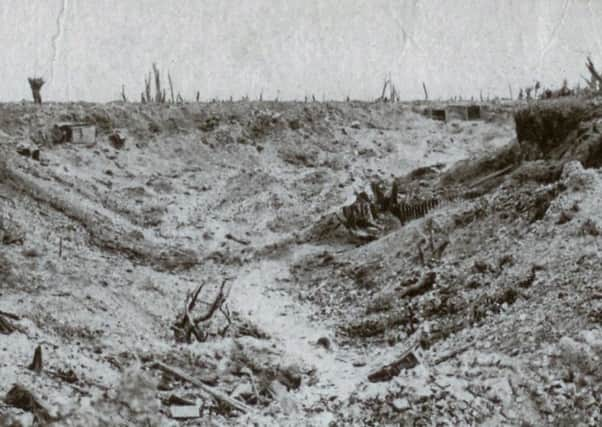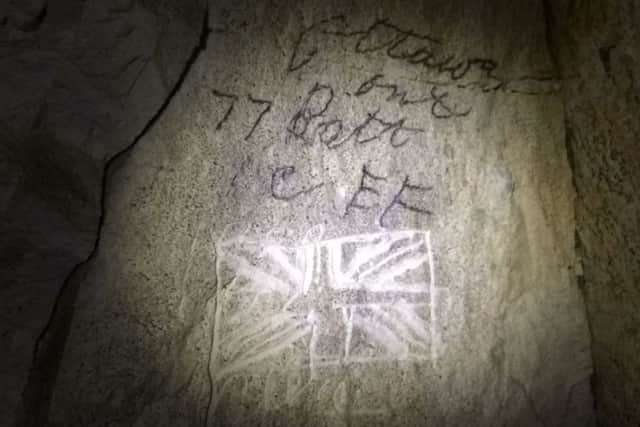Armistice centenary: Secret tunnels a '˜Middle Earth' sanctuary from dehumanised land


In the pitch blackness of a man-made cave 40ft beneath a village in Northern France, two words written by an unknown soldier in 1916 flicker in the pale light of a torch.
“Welcome home.”
In an instant, the message etched in pencil on a rock wall at the height of the Battle of the Somme flashes across the century the writer probably never got to see.
Advertisement
Hide AdAdvertisement
Hide Ad

Welcome to Les Muches de Bouzincourt – the hidden caves where British and Commonwealth soldiers found sanctuary in the bowels of the earth from the horrors in the world above. I was granted access to this rarely visited underworld by the villagers of Bouzincourt, near Albert, as they work to preserve the caves to keep alive the soldiers’ memory.
And down here in the dark, amid the remnants of First World War kit including helmets, bullets, tins of corned beef and a rifle left behind in the rush to return home after the Armistice, can be found the final messages and signatures of men from across the British Isles, Canada and Australia.
They scrawled and carved their final words in the soft chalk walls while sheltering here before heading into the trenches. Many of them would be dead within days – but their handwriting remains as fresh as if it had been written only seconds ago.
“We have found 2,100 names in all,” says Jean Luc Rouvillain, 56, the deputy mayor of Bouzincourt. “It’s just remarkable.”
Advertisement
Hide AdAdvertisement
Hide AdThe caves beneath the Church of St Honoré, the patron saint of French bakers, were built by an earlier generation of Bouzincourt villagers in the 16th century to protect their families from invaders.
Equipped with hard hats and torches, he leads the way through a small door inside the church and down a steep passageway below ground as the temperature drops by degrees with every step.
And then, in the thin beams of torchlight, the last words of the young men who died in the nearby trenches suddenly begin to reappear.
One after the other, the names stand out as if in a roll call – Harold Holness from Warwickshire, Thomas Morton from Birmingham followed by men from Scotland, Kent, Lancashire and Gloucester.
Advertisement
Hide AdAdvertisement
Hide AdSome inscriptions honour various regiments including one praising the “Die Hards” of the 17th Battalion of the Middlesex Regiment – the 1st Football Battalion – whose members included the former Tottenham player and first mixed heritage British Army officer Walter Tull.
The equipment found includes a Royal Field Artillery badge, buttons from British uniforms, cooking pots, coins, flasks, and a toothbrush. Even more personal items preserved by the caves’ constant temperatures are likely to be found as the villagers have begun to shift earth from chambers that are yet to be fully explored.
“Some of these passageways are too unstable,” Mr Rouvillain says. “We can’t go down there.”
The caves were never occupied by the Germans or even French soldiers. British unit war diaries suggest they may have been a well-kept secret – with one battalion billeted here referring only to being in “dugouts” in its official war record.
Advertisement
Hide AdAdvertisement
Hide AdAnd this underground realm could yet hold further secrets according to Jeff Gusky, a doctor, artist and explorer who has also been underground in Bouzincourt.
He believes JRR Tolkien, who spent 10 days in the village while serving in the Lancashire Fusiliers, may have been inspired by the caves when he created the Hobbit and Lord of the Rings.
Dr Gusky, a world leading expert in exploring the hidden underground environments of the First World War, says: “It’s inconceivable that Tolkien didn’t know about these caves. I believe this is the place where Lord of the Rings was born in his imagination.
“When you are down there, it’s Middle Earth. It’s an alternative universe where people are living underground because the surface of the Earth has become dehumanised.”
Advertisement
Hide AdAdvertisement
Hide AdSpeaking from the US, Dr Gusky adds: “This place is sacred ground for the British, but the British know so little about this hidden world. It was so close to the extreme violence of the Somme. Many of these young men would have died and what you are seeing is their last inscriptions on these walls.
“The Bouzincourt caves are ground zero in a bloody chapter in the history of the First World War. It’s an emotional moment when you enter these caves and put them in the context of the losses the British Army suffered on the Somme.”
As my journey into the dark vaults of Bouzincourt comes to an end, a message from 1918 reveals itself on one of the walls saying “la Guerre finie” – the war is over – above a cross scratched in the rock.
Emerging back from the stale air of the caves into the church, which was rebuilt after the war, Mr Rouvillain, takes a deep breath.
“The soldiers came from around the world and put their names on those walls,” he says.
“It’s important for us to remember them.”